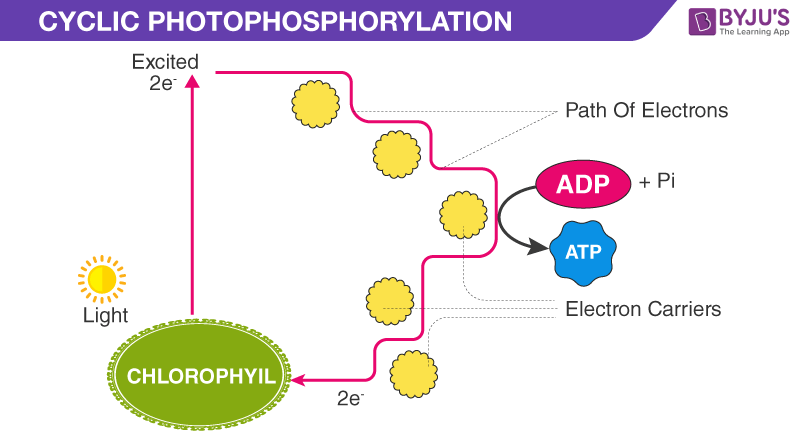
Cyclic Photophosphorylation happens with the help of photosynthesis, a process of producing carbohydrates by green plants using carbon dioxide and water in the presence of sunlight. The two-step process comprises:
- The light reaction which takes place in the grana of the chloroplast where light energy gets converted to chemical energy as ATP and NADPH. In this reaction, the addition of phosphate in the presence of light or the synthesizing of ATP by cells is known as photophosphorylation.
- While in the dark reaction, the energy produced previously in the light reaction is utilized to fix carbon dioxide to carbohydrates. This takes place in the stroma of the chloroplast.
When plants use light energy from photosynthesis to convert ADP to ATP, the process is known as photophosphorylation.
There are two types of photophosphorylation –
1) Cyclic Photophosphorylation
2) Non – cyclic Photophosphorylation

Cyclic Photophosphorylation
In prokaryotes, the process of photosynthesis helps in the production of energy and not for the formation of biological molecules. Cyclic Photophosphorylation is the process in which organisms (like prokaryotes), just accomplish the conversion of ADP to ATP for immediate energy for the cells.
This type of photophosphorylation usually occurs in the thylakoid membrane. The electron begins in a pigment complex called photosystem I in cyclic electron flow. It then further passes from the primary acceptor to ferredoxin and eventually to cytochrome b6f. Cytochrome b6f is similar to what is found in mitochondria. The electron then passes to plastocyanin before returning to chlorophyll.
A proton-motive force is produced throughout this electron transport chain which pumps H+ ions across the membrane and produces a concentration gradient that can be used to power ATP synthase during chemiosmosis. This entire pathway is known as cyclic photophosphorylation. It neither produces O2 nor NADPH.
Stay tuned with BYJU’S to learn more about the cyclic photophosphorylation and other related topics @ BYJU’S Biology.
Frequently Asked Questions
What is photophosphorylation?
Photophosphorylation is the process of producing ATP molecules from the ADP during the biological process of photosynthesis in the presence of light energy; therefore it is also called as the light-dependent reactions.
Where does photophosphorylation occur?
Photophosphorylation is the light-dependent reaction, which occurs in the chloroplasts of the plant cells, specifically, in the thylakoid membranes.
What is cyclic photophosphorylation?
It is the type of Photophosphorylation, which occurs within the lamellae of chloroplasts. Cyclic Photophosphorylation is a light-dependent reaction in which the high energy electrons are released in a cyclic pathway from P700 to PS-I.
Why is cyclic photophosphorylation important?
The cyclic photophosphorylation is required all the time as it can generate ATP at a low cost. Only photosystem-I is active in cyclic photophosphorylation.
What does cyclic photophosphorylation produce?
Cyclic photophosphorylation involves the use of photosystem-I. When light is absorbed by this photosystem, the excited electron enters the electron transport chain to produce ATP.


Nice amazing lesson